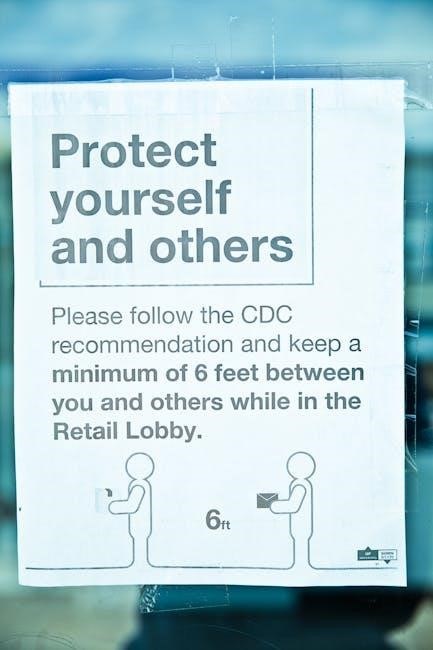Post-Op Extraction Instructions Overview
Following post-operative instructions ensures proper healing after tooth extraction. Key steps include controlling bleeding, managing pain, reducing swelling, and maintaining oral hygiene to promote recovery and prevent complications.
Importance of Following Instructions
Adhering to post-operative instructions is crucial for ensuring proper healing, minimizing complications, and reducing the risk of infection or prolonged recovery. Following guidelines helps maintain the blood clot, manage pain, and prevent swelling. Neglecting instructions can lead to dry socket, infection, or delayed healing. By carefully following advice on bleeding control, pain management, and dietary restrictions, patients can promote a smooth recovery. Proper care also reduces the likelihood of needing additional treatments. Consistency in following instructions ensures the best outcomes and supports the body’s natural healing process after tooth extraction.
General Guidelines for Recovery
General guidelines for recovery after tooth extraction emphasize rest, hydration, and a soft-food diet. Avoid strenuous activities, smoking, and alcohol for 24 hours. Keep the head elevated to reduce swelling. Monitor healing progress and watch for signs of complications. Gently rinse with warm salt water after 24 hours to maintain oral hygiene. Avoid disturbing the surgical site or dislodging the blood clot. Follow prescribed medications and dietary advice to support recovery. Stay hydrated to prevent dehydration and promote healing. If unusual symptoms arise, such as excessive bleeding or severe pain, contact your surgeon immediately. Proper care ensures a smooth and timely recovery.
Immediate Post-Operative Care
Immediately after surgery, bite on gauze for 30-60 minutes to control bleeding. Avoid spitting, rinsing, or smoking. Rest with your head elevated to reduce swelling.
First 24 Hours After Surgery
Avoid spitting, rinsing, or smoking for 24 hours. Do not drink through a straw or consume hot, cold, or sharp foods. Keep the extraction site undisturbed to allow blood clot formation. Apply ice packs to reduce swelling, and rest with your head elevated. Use gauze as directed to control bleeding. Stick to a soft food diet and avoid alcohol. Gentle mouth care is essential, but avoid disturbing the surgical area. Follow prescribed pain medications and stay hydrated. These steps ensure proper healing and minimize complications during the initial recovery phase.
Bleeding Management
Bleeding after tooth extraction is common and typically manageable. Bite firmly on the provided gauze for 30-60 minutes to help form a blood clot. Avoid spitting, rinsing, or sucking through a straw, as this can dislodge the clot. If bleeding continues, replace the gauze and apply pressure. Elevate your head and rest quietly to reduce blood flow. Minor oozing may persist for 1-2 days. If bleeding becomes heavy or uncontrollable, contact your surgeon immediately. Follow these steps to ensure proper clot formation and minimize the risk of complications during the healing process.
Pain and Discomfort
Pain and discomfort are normal after tooth extraction, often peaking within the first few hours. Use prescribed medications as directed to manage pain effectively. Over-the-counter options like ibuprofen can also help reduce discomfort. Avoid exceeding recommended dosages and follow your surgeon’s advice. Pain typically subsides gradually, improving within 1-5 days. Rest and avoid strenuous activities to promote healing. If pain becomes severe or persistent, contact your surgeon, as this could indicate complications. Proper pain management is crucial for a smooth recovery and to prevent unnecessary discomfort during the healing process.

Managing Bleeding
Control bleeding by biting firmly on gauze for 30-60 minutes; If bleeding continues, apply fresh gauze for another 30 minutes. Stay calm and avoid spitting or rinsing vigorously to prevent dislodging the clot, which is essential for healing. Additional gauze may be needed until bleeding subsides, typically within a few hours. Elevate your head and rest quietly to reduce bleeding. If bleeding persists, contact your surgeon for further guidance to ensure proper recovery.
Using Gauze to Control Bleeding
After tooth extraction, place a folded, damp gauze pad over the surgical site and bite down firmly for 30-60 minutes to create pressure. Check the gauze after 30 minutes; if it’s soaked with blood, replace it with a fresh one. Continue this process until bleeding slows, which may take several hours. Avoid spitting, rinsing, or using a straw, as these actions can dislodge the blood clot and worsen bleeding. Stay calm and keep your head elevated to reduce blood flow to the area. If bleeding persists despite these efforts, contact your surgeon for further guidance.
Duration of Bleeding Post-Extraction
Bleeding after tooth extraction typically lasts for 1-2 days, with the heaviest flow in the first few hours. Light oozing or pinkish saliva may continue for up to 24-48 hours. Most bleeding subsides within 8-12 hours, but slight traces can persist longer. Elevating the head and avoiding strenuous activities help minimize duration. If bleeding remains heavy or shows no improvement after 3-4 hours, contact your surgeon. Persistent or excessive bleeding beyond 24 hours may indicate complications needing medical attention. Monitoring and following post-op instructions carefully ensures bleeding resolves naturally within the expected timeframe.
Pain Management
Effective pain management after tooth extraction involves prescribed medications and over-the-counter options. Pain typically subsides within 1-5 days, with discomfort gradually decreasing during this period.
Prescribed Medications
Prescribed medications are essential for managing post-extraction pain. Follow your surgeon’s instructions carefully to ensure proper dosage and avoid complications. Pain relief typically starts within 1-2 hours of taking medication. Commonly prescribed medications include opioids or NSAIDs, such as ibuprofen, to reduce inflammation and discomfort. Always take medication with food to minimize stomach upset. Do not exceed the recommended dosage, as this can lead to side effects. If pain persists or worsens despite medication, contact your surgeon immediately for further evaluation and guidance.
Over-the-Counter Pain Relief Options
Over-the-counter pain relief options, such as ibuprofen (e.g., Advil) or acetaminophen (e.g., Tylenol), can effectively manage mild to moderate post-extraction pain. Ibuprofen reduces inflammation and alleviates discomfort, while acetaminophen focuses on pain relief without anti-inflammatory properties. Always follow the recommended dosage on the label or as advised by your surgeon. Avoid exceeding the maximum daily dose to prevent side effects. For optimal relief, take medication as directed and before pain becomes severe. If pain persists or worsens despite OTC medications, consult your surgeon for stronger prescription options or further evaluation.

Swelling and Bruising
Swelling and bruising are normal after extraction, peaking around days 2-3, then subsiding within 48-72 hours. Ice packs can reduce swelling, while bruising fades over a week.
Reducing Swelling with Ice Packs
To minimize swelling after tooth extraction, apply an ice pack or a bag of ice wrapped in a cloth to the affected cheek. Use it alternately, 20 minutes on and 20 minutes off, especially during the first 12 hours post-procedure. This technique helps constrict blood vessels, reducing inflammation and discomfort. Continue this process as needed, ensuring the ice does not directly touch the skin to avoid irritation. Consistent application within the initial 24-48 hours will significantly aid in reducing swelling and promoting faster healing.
Timeline for Swelling Subsidence
Swelling typically peaks within the first 24-48 hours after surgery and gradually subsides. Most noticeable swelling resolves within 3-5 days, while mild swelling may linger for up to 7-10 days. By day 7, significant improvement is expected, with residual swelling disappearing by day 14. Elevating the head, using ice packs, and following post-operative care instructions can expedite this process. Patients should expect swelling to decrease progressively, with discomfort lessening as healing advances. If swelling persists or worsens after 7 days, consult your surgeon to rule out complications.
Dietary Recommendations
Stick to soft, non-irritating foods for the first 24 hours, such as yogurt or mashed potatoes. Avoid hot, sharp, or hard foods that could disrupt healing or irritate the site.
First 24 Hours: Soft Foods
During the first 24 hours after tooth extraction, it’s crucial to consume soft, non-irritating foods to minimize discomfort and protect the surgical site. Opt for foods like yogurt, scrambled eggs, mashed potatoes, and applesauce. Avoid hot or sharp foods that could dislodge the blood clot or irritate the area. Cold foods can help reduce swelling but should not be excessively cold. Stay hydrated by drinking water or clear broths, but avoid using a straw to prevent dislodging the clot. Proper nutrition supports healing, so choose nutrient-rich, easy-to-eat options to ensure a smooth recovery process during this initial phase.
Avoiding Hot, Cold, or Sharp Foods
Avoid consuming hot, cold, or sharp foods immediately after tooth extraction to prevent discomfort and complications. Hot foods can irritate the surgical site, while cold foods may cause discomfort or swelling. Sharp or hard foods can dislodge the blood clot, delaying healing. Avoid foods like chips, nuts, or crusty bread. Instead, opt for soft, room-temperature foods like mashed bananas, oatmeal, or soft-cooked vegetables. This helps protect the extraction site and ensures proper healing. Adhering to this guideline reduces the risk of complications and supports a smoother recovery process during the initial stages of healing.
Oral Hygiene
Maintain gentle oral hygiene to promote healing. Avoid harsh mouthwashes and instead rinse with warm salt water after meals. Brush teeth carefully, avoiding the surgical site, and refrain from forceful spitting or rinsing to protect the blood clot and ensure proper recovery.
Brushing Teeth After Extraction
Begin brushing your teeth gently the day after surgery, avoiding the extraction site. Use a soft-bristled toothbrush and mild toothpaste. Avoid forceful spitting or rinsing, as this can dislodge the blood clot. For the first 24 hours, do not brush the surgical area directly. After 24 hours, you may rinse with warm salt water to keep the area clean. Continue brushing your other teeth normally, taking care not to disturb the healing site. Proper oral hygiene helps prevent infection and promotes a smooth recovery. Avoid using harsh mouthwashes initially and opt for gentle rinsing instead.
Rinsing Techniques
After tooth extraction, avoid rinsing your mouth for the first 24 hours to protect the blood clot. On the second day, start rinsing gently with warm salt water (1/2 teaspoon of salt in 8 ounces of water) after meals to keep the area clean. Repeat this 2-3 times a day to promote healing and reduce the risk of infection. Be gentle to avoid dislodging the clot, which is crucial for proper recovery. Continue this rinsing technique for up to two weeks or as advised by your surgeon, ensuring the site remains clean without disrupting the healing process.

Recovery Timeline
Day 1: Immediate healing begins with clot formation. Days 2-3: Swelling peaks and discomfort gradually subsides. Week 1: Noticeable reduction in swelling and discomfort, promoting a smoother recovery process.
Day 1: Immediate Healing Phase
On the first day after surgery, focus on controlling bleeding and protecting the extraction site. Bite firmly on gauze for 30-60 minutes to promote clot formation. Avoid rinsing, spitting, or using a straw to prevent dislodging the clot. Rest with your head elevated to reduce swelling; Pain and discomfort are normal, but manageable with prescribed or over-the-counter pain relievers. Limit physical activity to avoid disrupting the healing process. Monitor for excessive bleeding or unusual symptoms, and contact your surgeon if concerns arise. Stick to a soft-food diet and avoid hot, cold, or sharp foods that could irritate the site.
Days 2-3: Progression of Healing
By Days 2-3, swelling typically reaches its peak and begins to subside. Gentle rinsing with warm salt water can commence after 24 hours to keep the area clean. Pain and discomfort gradually decrease, though sensitivity may persist. Stick to a soft-food diet, gradually introducing more solid foods as comfort allows. Avoid chewing directly over the extraction site. Light brushing around the area is permissible, but avoid disturbing the surgical site. Monitor for signs of infection, such as increased redness or pus. If pain worsens or bleeding resumes, contact your surgeon promptly for guidance.
Week 1: Swelling and Discomfort Reduction
By Week 1, most swelling and bruising significantly subside, and discomfort decreases. Patients can gradually resume normal activities and dietary habits. Continue rinsing with warm salt water to maintain cleanliness. Avoid strenuous activities that may dislodge the blood clot. Soft foods can transition to more solid foods as comfort allows. Gentle brushing near the extraction site is encouraged. Monitor for any signs of infection, such as redness or pus. If pain persists or worsens, contact your surgeon. Stay hydrated and avoid smoking or alcohol to support healing. Full recovery typically progresses smoothly by the end of the first week.

Complications to Watch For
Monitor for signs of infection, excessive bleeding, severe pain, or increased swelling. Contact your surgeon immediately if these complications arise to ensure proper healing and address concerns promptly.
Signs of Infection
After tooth extraction, monitor for signs of infection, such as increased redness, swelling, or pain at the surgical site. Other indicators include pus or discharge, fever, or a foul taste in the mouth. If you experience severe pain that persists or worsens, or if swelling does not subside within a few days, contact your surgeon immediately. Untreated infections can delay healing and lead to complications. Prompt medical attention is essential to address any unusual symptoms and ensure proper recovery.
Excessive Bleeding or Prolonged Pain
Excessive bleeding that lasts beyond the first 24 hours or soaks more than two gauzes per hour is a cause for concern. Similarly, prolonged pain that does not improve with prescribed medication or worsens over time may indicate complications. Contact your surgeon if you experience these symptoms. Bleeding that persists despite applying gauze or pain that radiates to other areas should be evaluated promptly. These could signal issues such as infection or dry socket, requiring immediate attention to ensure proper healing and prevent further complications.
Follow-Up Care
Regular follow-up appointments are essential to monitor healing progress and address any concerns. Your surgeon will schedule these visits to ensure proper recovery and handle any issues promptly.
Importance of Post-Operative Check-Ups
Post-operative check-ups are crucial for monitoring the healing process and ensuring no complications arise. These visits allow your surgeon to assess the extraction site, check for proper clot formation, and confirm that swelling and pain are subsiding as expected. Early detection of potential issues, such as infection or dry socket, can prevent prolonged recovery. Additionally, follow-up appointments provide an opportunity to address any concerns or questions you may have. Regular check-ups help ensure a smooth and successful recovery, minimizing the risk of long-term complications and promoting optimal healing outcomes.
When to Contact Your Surgeon
Contact your surgeon immediately if you experience excessive bleeding that doesn’t stop with gauze pressure, severe pain not relieved by medication, swelling that worsens after 3-4 days, or signs of infection like fever, redness, or pus. If you notice unusual numbness, tingling, or a foul odor from the extraction site, seek medical attention. Additionally, reach out if you have difficulty breathing, an unusual reaction to medication, or concerns about the healing process. Timely communication ensures complications are addressed early, promoting a safer and more effective recovery.
Additional Tips
Avoid smoking and alcohol for 24 hours, as they delay healing. Stay hydrated with water and avoid carbonated drinks. Refrain from using straws and opt for soft, lukewarm foods.
Smoking and Alcohol Avoidance
Smoking and alcohol consumption should be avoided for at least 24 hours after tooth extraction. Smoking delays healing by reducing blood flow to the surgical site and can lead to complications like dry socket. Alcohol can interfere with blood clot formation and prolong bleeding. Additionally, alcohol may interact with prescribed pain medications, increasing the risk of side effects. Avoiding these habits promotes a smoother recovery and reduces the chance of post-operative issues. Your surgeon may recommend extending the period of avoidance based on individual circumstances.
Staying Hydrated
Staying hydrated is crucial after tooth extraction to aid healing and prevent complications. Drink plenty of water, clear broths, or electrolyte-rich beverages to maintain fluid balance. Avoid caffeine and carbonated drinks, as they can cause discomfort or dehydration. Sip slowly and avoid using a straw, as suction can dislodge the blood clot. Proper hydration helps prevent dry mouth, promotes healing, and supports overall recovery. Aim to drink fluids regularly, especially during the first 24-48 hours, to ensure a smooth and comfortable recovery process.